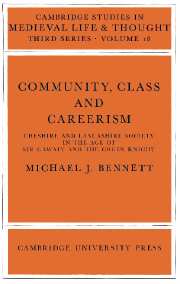Book contents
- Front Matter
- Contents
- List of maps and tables
- Acknowledgements
- Abbreviations
- Genealogical table
- Introduction
- 1 THE REGIONAL SOCIETY
- 2 THE COUNTY COMMUNITIES
- 3 LESSER SOLIDARITIES
- 4 THE POPULATION
- 5 LANDED SOCIETY
- 6 THE PEASANTRY
- 7 TOWNS, TRADE AND INDUSTRY
- 8 THE CHURCH
- 9 MILITARY SERVICE
- 10 POWER, PATRONAGE AND PROVINCIAL CULTURE
- 11 CONCLUSION
- Bibliography
- Index
- Front Matter
- Contents
- List of maps and tables
- Acknowledgements
- Abbreviations
- Genealogical table
- Introduction
- 1 THE REGIONAL SOCIETY
- 2 THE COUNTY COMMUNITIES
- 3 LESSER SOLIDARITIES
- 4 THE POPULATION
- 5 LANDED SOCIETY
- 6 THE PEASANTRY
- 7 TOWNS, TRADE AND INDUSTRY
- 8 THE CHURCH
- 9 MILITARY SERVICE
- 10 POWER, PATRONAGE AND PROVINCIAL CULTURE
- 11 CONCLUSION
- Bibliography
- Index
Summary
In theory the church provided an honourable career structure open to all the talents. Given the requisite ability and dedication, even the humblest ploughboy might rise to become an eminent abbot or bishop. Needless to say, his climb to the top would be far more arduous than the gentle slope encountered by the young nobleman. The positions at the summit were in any case limited in number and strongly contested. Yet, when all the injuries of class and obstacles to progress have been noted, it remains substantially true that the church in late medieval England provided an avenue of advancement viable to men of all ranks. There were, after all, no absolute restrictions on members of the lower orders obtaining an educatíon or entering the priesthood. Moreover, even the poorest curate enjoyed a measure of privilege and esteem denied the layman. Nor were opportunities for material profit lacking at any level of the ecclesiastical hierarchy. With the possible exception of the mendicants, most clergymen could expect to make at least modest advances on the fortunes to which their birth entitled them.
The church was by no means a monolithic institution, and the clergy were far from homogeneous as a class. In the following discussion of clerical careerism, therefore, two rather different perspectives are adopted in turn. In the first place the church is viewed as a self-contained body providing in various ways for the spiritual needs of the faithful.
- Type
- Chapter
- Information
- Community, Class and Careers , pp. 134 - 161Publisher: Cambridge University PressPrint publication year: 1983

